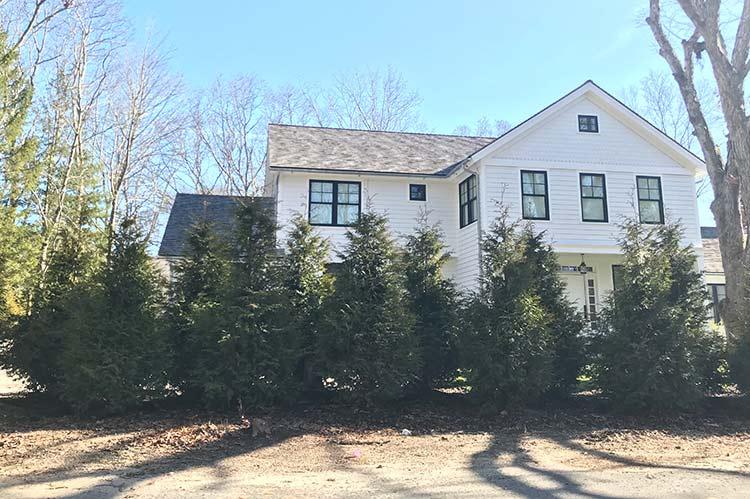Long Island’s South Fork, known for beaches, maritime history, and fancy people, is also known for its hedges. Hedge installation and maintenance are big business, and there could be a whole book about hedges, with different varieties popular during different eras. In the last decade, for example, the “green giant,” a now ubiquitous tree, has been placed along property lines throughout the Hamptons. It’s here to stay, and grow, and grow.
“Nobody knows how high they’re going to get. The thing that bothers me the most is that they’re going to start blocking out sky view in certain areas. If I was the neighbor on the north side of someone who planted a green giant hedge, I’d be upset. They really want to be big trees,” said Tony Piazza, owner of Piazza Horticultural Group.
“A green giant can put on up to five feet of growth per year,” said Dana Tripp, a board-certified arborist with Whitmores in East Hampton. “They can grow up to 80 feet tall.” He called it a stable tree, which he was not opposed to, but acknowledged it could be controversial. “Every arborist will have a different opinion on that.”
First introduced to the United States in 1967, green giant is the name given to the hybridization of the western red cedar (Thuja plicata) and a Japanese species (Thuja standishii). “They’ve been overused in the last five to 10 years,” said Mr. Piazza. “All they really do is take from our ecosystem. They require a lot of water and take nutrients out of the soil at a rate a native plant wouldn’t.”
The tree is a deep green. When it’s not trimmed into a hedge, it has a pyramid-like structure: broad at the base and very narrow at the top. “They have value as a screen, which is the equivalent to putting up a fence. But it’s hard to get lower for wildlife value. Although Leyland cypress does go lower,” said Douglas Tallamy, author of “Bringing Nature Home.” “They’re thick, so you might get a robin to nest in one, but the green giant would produce no food to feed its babies. Planting them assumes there’s endless insects out there to feed their young.”
Importantly, he noted that the green giant hosts no caterpillar species. Birds are dependent on caterpillars to feed their nestlings. Because green giants are non-native, they might as well be from another planet; our birds and insects don’t interact with them. So, while the trees can be impressive and green, if they surround a square of sod, the birds and insects are dealing with a green desert.
“The bottom line is that ecosystem function always takes a back seat,” said Mr. Tallamy. “It’s never a primary goal, and that’s our issue everywhere. But people are going to listen to what they want to hear.”
Because the species is relatively inexpensive and can be found easily at a place like Home Depot (“They’re cranking them out like cookies,” said Mr. Piazza), in some cases they are used as a disposable hedge that’s expected to last only a decade before being ripped out and replanted.
If it sounds counternatural, it is, but according to Mr. Piazza, the trees are popular because they’re good at what they do.
“They’re fast-growing, and the deer don’t go after them in the way they go for other arborvitae,” he said. (Other experts indicated deer have begun to find them.) “They seem to be able to thrive in partial shade and full sun. They’re pretty adaptable. Houses out here are getting bigger. If you need to screen the second story of a McMansion, privet hedge is just never going to get that tall.”
Deciduous trees, and native shrubs like bayberry, are being replaced by green giants. So, while they’re not invasive and won’t start appearing in our parklands like ailanthus trees, they’re still taking up space that could be used by native plants with ecological benefit.
“Maybe we deserve this plant,” said Mr. Piazza.
Then there’s the aesthetics and the message that walls of green send. Conventional wisdom tells us we’re divided politically, that smartphones are making us stupid, and that social media is the antithesis of social behavior. “Maybe we don’t have to stake out our territory with these 60-foot hedges?” Mr. Piazza remarked. “You can’t chat with your neighbor over such a wall. So, are there alternatives?
“If you want a total screen, that’s an issue,” said Mr. Tallamy. “Eastern red cedar provides a looser screen, and they also make berries that birds eat, and support several species of caterpillar. They’re not fancy, but they grow fast. Just not as fast as this other thing.”
“I’m not a straight hedge person, unless it’s a formal garden,” said Mr. Piazza. “A mixed planting would be much more desirable, using Eastern red cedar, with the knowledge that it will lose its “skirt” due to deer browse. But you can mix in bayberry to help screen the bottom part, some viburnums, and American holly. Green giants can be part of a hedge, but people need to use them judiciously. A mixed tapestry of plants, without using a row of plants that aren’t native to here, is best.”

